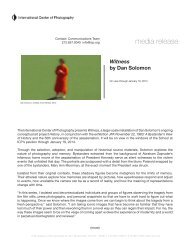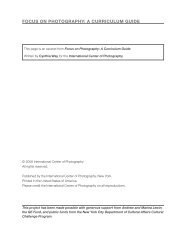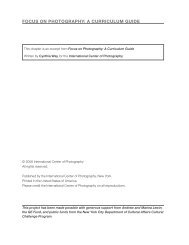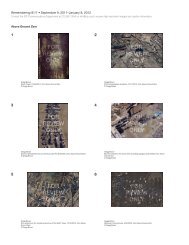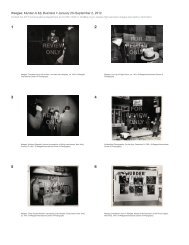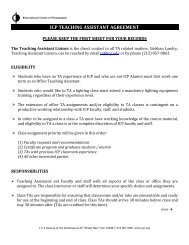Press Release PDF - International Center of Photography
Press Release PDF - International Center of Photography
Press Release PDF - International Center of Photography
Create successful ePaper yourself
Turn your PDF publications into a flip-book with our unique Google optimized e-Paper software.
Contact: Communications Team<br />
212.857.0045 info@icp.org<br />
media release<br />
We Went Back:<br />
Photographs from Europe<br />
1933–1956 by Chim<br />
On view from<br />
January 18, 2013<br />
through<br />
May 5, 2013<br />
Media Preview<br />
January 17, 2013<br />
11:30 am–1:30 pm<br />
RSVP:<br />
info@icp.org<br />
212.857.0045<br />
Chim, [Woman nursing a baby at a land reform meeting, near Badajoz,<br />
Extremadura, Spain], April– May 1936. © Chim (David Seymour)/ Magnum<br />
Photos.<br />
We Went Back: Photographs from Europe 1933–1956 by Chim, a new exhibition tracing the life and work<br />
<strong>of</strong> one <strong>of</strong> the most respected photojournalists <strong>of</strong> 20th-century Europe, will be on view at the <strong>International</strong><br />
<strong>Center</strong> <strong>of</strong> <strong>Photography</strong> (1133 Avenue <strong>of</strong> the Americas at 43rd Street) January 18–May 5, 2013.<br />
This retrospective exhibition follows the development <strong>of</strong> Chim’s career as an intellectually engaged<br />
photojournalist, placing his life and work in the broader context <strong>of</strong> 1930s–50s photography and European<br />
politics. Born Dawid Szymin in 1911 in Warsaw, Chim, who after World War II published under the name<br />
David Seymour, began his career in 1933 photographing regularly for leftist magazines in Paris, even before<br />
his close friends and collaborators Robert Capa and Henri Cartier-Bresson. His most celebrated reportages<br />
include the rise <strong>of</strong> the Popular Front in prewar France; the Spanish Civil War, which he covered alongside<br />
Capa and Gerda Taro; the postwar reconstruction <strong>of</strong> Europe; and the birth <strong>of</strong> Israel. In each <strong>of</strong> his images, he<br />
combined rare intellectual acumen and emotional intelligence.<br />
“Chim was a keen observer <strong>of</strong> European political affairs, from the beginnings <strong>of</strong> the antifascist struggle to<br />
the rebuilding <strong>of</strong> countries ravaged by World War II,” said ICP Curator Cynthia Young, who organized the<br />
exhibition. “Although war formed the backdrop to much <strong>of</strong> his reportage, Chim was not known primarily<br />
for his war photography. Through his images <strong>of</strong> this period <strong>of</strong> radical upheaval, he emerges as a thoughtful<br />
reporter and a creator <strong>of</strong> elegant compositions <strong>of</strong> startling grace and beauty.”<br />
(more)<br />
1133 Avenue <strong>of</strong> the Americas at 43rd Street New York NY 10036 T 212 857 0045 F 212 857 0090 www.icp.org
Some <strong>of</strong> his photographs are well known—a woman nursing a child during a political meeting in Spain, a<br />
Polish girl in front <strong>of</strong> a drawing <strong>of</strong> her “home” after World War II, Picasso in front <strong>of</strong> his painting Guernica,<br />
a wedding in the new state <strong>of</strong> Israel—but other lesser known images are just as striking—workers at the<br />
Vatican waiting for lunch, a tomato garden in the postwar ruins <strong>of</strong> Frankfurt, children playing on Omaha<br />
Beach in front <strong>of</strong> a half-sunk military boat. These images delineate a sophisticated documentary practice in<br />
which Chim infused the informative detail with metaphor.<br />
We Went Back encompasses more than 150 mainly vintage black-and-white prints, previously unseen color<br />
prints—including a newly discovered box <strong>of</strong> transparencies from 1947—and personal ephemera. All <strong>of</strong> the<br />
material in the show is from the collections <strong>of</strong> ICP and Chim’s nephew Ben Shneiderman, niece Helen Sarid,<br />
and extended family.<br />
The Szymin family ran a publishing house in Warsaw that specialized in Hebrew and Yiddish translations <strong>of</strong><br />
European and American classic novels as well as contemporary Yiddish writers. To prepare for entry into the<br />
family business, Chim studied first in Leipzig, then at the Sorbonne in Paris, where he moved in 1932. His<br />
career path was diverted when, to cover living expenses, he picked up a camera and began photographing<br />
Popular Front events for the major French picture magazine Regards. Because “Szymin” was too complicated<br />
to pronounce or spell, he proposed “Chim” as a byline and the name stuck. In the spring <strong>of</strong> 1936, he was<br />
sent to Spain to report on the mood <strong>of</strong> the country following the recent elections. Within months his work<br />
was widely published in the international picture press, and he became, along with Capa and Taro, one <strong>of</strong> the<br />
most important photographers <strong>of</strong> the conflict in Spain.<br />
Back in Paris in 1939, Chim faced terrible prospects as a Jew, a foreigner, and a leftist. In May, he escaped<br />
France in a boat with Spanish refugees sailing to Mexico. Later that year, he arrived in New York, where<br />
he reconnected with Capa, his sister Eileen Shneiderman, and other friends. He was naturalized as a U.S.<br />
citizen in 1942, under the name David Seymour. When World War II broke out, Chim enlisted in the U.S. Army<br />
and was assigned to aerial photo reconnaissance at Medmenham, England. He arrived in Paris days after<br />
the liberation in 1944. In 1947, he founded the collective Magnum Photos with Capa, Cartier-Bresson, and<br />
George Rodger. That same year, he photographed daily life in Allied and Axis territories two years after the<br />
war ended for a story titled “We Went Back,” which effectively relaunched his career as a photojournalist.<br />
Chim traveled incessantly for the next nine years on assignment for international magazines and special<br />
projects, publishing under the byline David Seymour. In 1948, he documented the impact <strong>of</strong> the war on<br />
children across Europe for a UNESCO commission and spent several years observing postwar Italy and its<br />
transition to democracy. Beginning in 1951, he traveled regularly to Israel to document the new country and<br />
life <strong>of</strong> the settlers. He was killed while photographing the Suez Crisis in November 1956.<br />
We Went Back is a long overdue reevaluation <strong>of</strong> Chim’s career, made possible by new scholarship on<br />
recently discovered negatives from the so-called Mexican Suitcase and newly catalogued vintage prints.<br />
The accompanying exhibition catalogue, published by DelMonico Books/Prestel in association with ICP,<br />
contains essays by Roger Cohen, Carole Naggar, and Cynthia Young; more than 150 plates; and an illustrated<br />
publication history. Cohen is a columnist for the <strong>International</strong> Herald Tribune and The New York Times and<br />
has worked as a foreign correspondent in fifteen different countries. Naggar is the author <strong>of</strong> the Photo Poche<br />
David Seymour (Actes Sud, 2011). Young most recently organized the exhibition The Mexican Suitcase: The<br />
Rediscovered Spanish Civil War Negatives <strong>of</strong> Capa, Chim, and Taro and edited its award-winning catalogue<br />
(2010).<br />
This exhibition is made possible by The John and Anna Maria Phillips Foundation, National Endowment for<br />
the Arts, The Bernard Lee Schwartz Foundation, Inc., by public funds from the New York City Department <strong>of</strong><br />
Cultural Affairs in partnership with the City Council, and with the support <strong>of</strong> the Polish Cultural Institute New<br />
York.<br />
(more)<br />
1133 Avenue <strong>of</strong> the Americas at 43rd Street New York NY 10036 T 212 857 0045 F 212 857 0090 www.icp.org
About ICP<br />
The <strong>International</strong> <strong>Center</strong> <strong>of</strong> <strong>Photography</strong> (ICP) is the world’s leading institution dedicated to the practice and<br />
understanding <strong>of</strong> photography and the reproduced image in all its forms. Through our exhibitions, educational<br />
programs, and community outreach, we <strong>of</strong>fer an open forum for dialogue about the role images play in our<br />
culture. Since our founding, we have presented more than 500 exhibitions and <strong>of</strong>fered thousands <strong>of</strong> classes,<br />
providing instruction at every level. ICP is a center where photographers and artists, students and scholars<br />
can create and interpret the world <strong>of</strong> the image within our comprehensive educational facilities and archive.<br />
Visit www.icp.org for more information.<br />
# # #<br />
1133 Avenue <strong>of</strong> the Americas at 43rd Street New York NY 10036 T 212 857 0045 F 212 857 0090 www.icp.org



